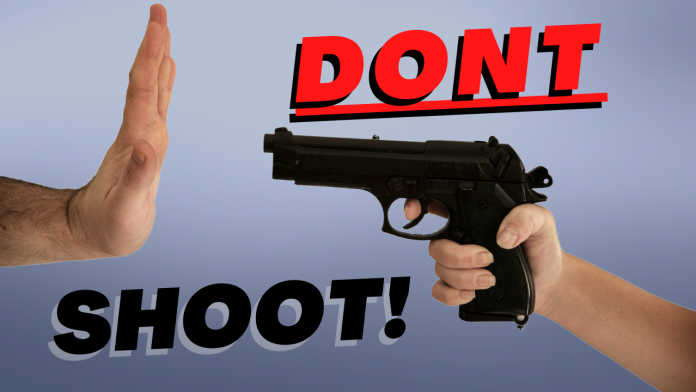
Do you ever practice not shooting?
That’s kind of a weird concept, right? It’s virtually impossible to practice not doing an action.
Why would we need to do that anyways?
In the training space, there’s been a heavy focus over the past few years on pushing the boundaries of human performance in terms of both draw times and splits (the time between shots).
There is always merit to holding oneself to a higher standard, never accepting the status quo, and trying to constantly improve, however this focus on pushing performance isn’t always tempered with the context of application in the context of the civilian defender.
This can pose some challenges.
Like it or not, we live in a society where public opinion can influence the course of the aftermath of a defensive encounter.
If you’re regularly banging out 2-second Bill Drills, that type of shooting can result in an attacker getting shot “excessively” or “in the back”. CAN these things be articulated, and a jury be educated as to why they can fall within the realm of reasonableness? Absolutely. But are you hoping that your attorney and expert witnesses able to sway the opinion of a retired school teacher who spent decades espousing “we solve problems with our words, not our hands?” Also yes.
There’s 3 different branches to this “not shooting people” angle:
#1: They Don’t Need Shot Yet
This is where scenario-based training such as Force-on-Force or Hardwired Tactical Shooting’s Counter-Robbery curriculum comes into play. Situations that put you under a cognitive load, and you have to determine if and when it’s appropriate to produce or apply a weapon.
#2: They Don’t Need Shot Anymore
Darryl Bolke likes to drive the point home that every round fired is its own individual use of force decision, requiring independent justification. Going back to the Bill Drill example, just because dude needed shot on round 1 doesn’t necessarily mean you’re cleared hot for all 6.
Whether the target drops their weapon, stops advancing, or whatever else, at some point they’re no longer presenting a reasonable threat to you. If you continue putting rounds into them after that point, it’s entirely possible that you’re at the very least complicating your defense and, worst case scenario, have surpassed the window of justifiable homicide entirely.
A glaring example of this was the Houston taqueria shooting, and a less clear-cut example was the officer involved shooting of Toni McBride, the LAPD officer who also shot competition. Despite the fact that her shots were by all accounts very measured controlled pairs, and she suffered no criminal charges, her department did find her in violation of policy with her last two rounds.
The Force Science Institute has done a ton of research on human reaction time and how it applies to defensive uses of force. I highly suggest people familiarize themselves with that data, and pursue some training that puts them in a position where they can make an inappropriate shooting decision.
#3: The Target Moved
People move when you shoot at them. Either because the initial round(s) had the desired effect, or because they’re trying to get out of the line of fire. Either way, there are examples from both Force-on-Force and real world encounters where the shooter sent rounds where the target was/should have been, but the target was no longer there. In the most recent FOF iterations I observed, this resulted in errant rounds being sent out into public, and landing on someone in the circle of spectators. Jared Reston also shares one of his experiences that could have ended a LOT worse than it did.
I’ll close out by saying that I’m not trying to claim shooting performance doesn’t matter. My point is simply that it’s the easiest component to focus on since it’s so quantifiable. All you need to work on your shooting performance is some ammo, a timer, and a time & accuracy standard. Working on the cognitive aspects of the defensive problem require more people, more time, and less measurable performance. But I’d argue that the skills are equally, if not more important.
To the critics who claim “I’ll slow down/make the right choice when it counts” I’ll just say that at last year’s Rangemaster Tactical conference, one of the attendees that made the top 16 man-on-man shoot-off found himself a little overwhelmed and bound up when it was his turn in the scenario based training. Yes, having automaticity in your shooting skills frees up RAM to focus on problem solving, but if that problem overwhelms your processing ability, you’re less likely to initiate the automated programs appropriately.



